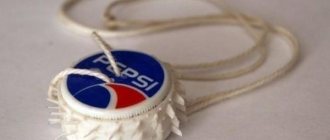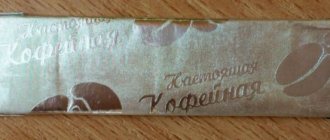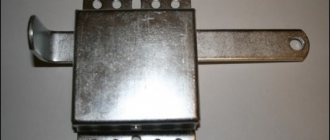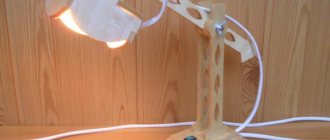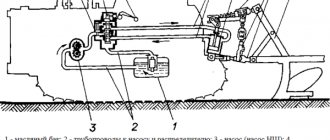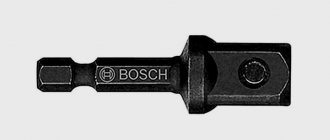You might be interested
Building materials Which is better - a frame house or one made of timber: a comparison of technological qualities If previously getting an apartment in a high-rise building was the ultimate dream of many Russians... Evgeniy Afanasyev 5492 0
Building materials Which plaster to choose for the facade of a house and you can’t go wrong: rating of the best materials Plaster is one of the oldest types of finishing of building facades. But, despite... Evgeny Afanasyev 1904 0
Construction materials Is it possible to sheathe a bathhouse with foil insulation? Many non-specialists believe that the bathhouse does not need to be insulated, and even if... Ekaterina Volotkovich 77169 0
Construction materials Rating of waterproofing products: TOP-12 of the best materials It is impossible to imagine any construction without waterproofing measures. And... Evgeniy Afanasyev 3898 0
Building materials Substrate for laminate, which one to choose: TOP-13 best manufacturers Laminate is often used as flooring in apartments and other... Artem Masalsky 2932 0
How does a blender work?
Nature has created three types of blenders:
- Stationary.
- Manual (submersible).
- Complementary composition of the food processor.
The blender design in each case provides for the presence of an electric motor - the initial driving force; the principle of operation changes according to the tasks performed. Stationary blenders are reminiscent of replenishing combines. You will see two characteristic prefabricated units that help the device perform its duties:
- Engine.
- Bowl with knife.
Let's talk about how the product works. The knife rotates quickly in the bowl, where the chopped products are placed. A specific blade causes the contents to move along a closed path. The knife is located at the bottom. When the electric motor transmits torque to the blade through the output shaft and spindle, the blade's revolutions quickly increase. Due to the speed (thousands of revolutions every minute), the effect of movement of the crushed mass is obtained. The envelope of the blender blade resembles a propeller. The cross pulls fruits and vegetables on top of itself, and throws crushed pieces to the sides.
Then the profile of the bowl comes into play, twisting the movement of the food mass. The walls expand upward, so under the pressure of the flow coming out of the knife, the mash begins to creep upward. In the center, pieces of food fall down. The processed mass reaches the lid and falls back onto the knives. The described process proceeds at a speed beyond the grasp of the eye.
The considered cycle occurs ideally in strong blenders. Cheap household models do not have enough revolutions to establish closed motion. The knife cuts the void. Therefore, wanting to chop the cabbage, the cook is forced to add water. The step releases the laws of hydrodynamics, which come into play, making the work of the knives easier. So first! Before fixing the blender (which may not have broken):
- If a low-power blender does not want to grind the mass, the fact does not indicate a 100% malfunction. Try adding water, milk, juice, and repeat the process.
- A simple fact means: the blade of the blender is dull, the speed switch is broken, the engine lacks the necessary power. The masters say: the problem affects the bowl. More precisely, it lies in the rotating joint of the knife.
One or two nozzles?
When choosing a construction mixer, you can see that some models of this tool are equipped with two spindles, which allows you to install two rotating attachments at once. The differences between them are obvious. Double-spindle mixers are designed to work with large volumes of finishing mixture during prolonged use. The speed of operation can also be added to the advantages; such a mixer will quickly make the mixture homogeneous. And, naturally, it costs more, so unless you plan to use the mixer every day, choose a mixer with a single spindle.
Cream “Ice cream”
Category: Desserts Other desserts Dessert creams
Dear cooks, hello! I use this cream in many of my cake and sweet recipes. The plan was to separate it into a separate recipe. The cream is delicate, light, airy, pleasant, aromatic, creamy. Tastes similar to ice cream. They can be used to fill cakes: tubes, eclairs, profiteroles, and to coat cake layers. I'll attach a photo at the end of the recipe as an example. The cream is easy to prepare and very tasty! I will be glad if the recipe is useful!
Milk Sugar Chicken egg Wheat flour Butter Vanillin Salt Cognac
How a garden tool can become a construction tool
To make hand mixing concrete easier, you will need two things. The first of these is suitable containers. It is clear that you are unlikely to buy anything specifically for this purpose; they usually use what is at hand. The best option is an oblong trough. Not a round basin, but an oblong container like a baby bath.
And the second tool, a little unexpected for construction - a garden hoe, or hoe, as it is called in the south. It is this, and not a traditional shovel, that is the most suitable tool for mixing. When mixing with a shovel, you have to lift the solution and turn it over, which puts additional stress on your arms and back.
Advantages and disadvantages
The main advantage of the drill mixer is the possibility of its multifunctional use. On the one hand, the tool is classified as a drill, therefore, in addition to mixing mortars, it can be used to form holes in various types of surfaces, even the hardest and densest. On the other hand, a drill of this type belongs to the low-speed category, so it cannot replace a drill 100%, but at the same time, it is the low speeds that make it possible to mix even the densest mixtures.
Obviously, such a design cannot be used in industrial quantities; its power and design features are not enough to cope with intensive operation. But it can handle small household tasks such as minor repairs and finishing of an apartment or private house in full.
Such a drill weighs much more than a regular one: its mass is more than 3 kg, so frequent drilling with such a unit involves significant physical effort.
Advantages of do-it-yourself puttying
By entrusting the work to professional builders, you will save yourself a lot of hassle. But demands on the quality of work and the financial aspect often force one to choose in favor of self-repair. You can putty yourself without resorting to the help of professionals, because:
The first thing you have to worry about before going to the store is choosing the type of putty mixture. Based on the composition of putty mixtures, they are divided into:
You choose the type of putty depending on the type of surface it will cover. They must be compatible and interact with each other as efficiently as possible to create reliable adhesion of the upper layers. You can putty on a base made of plasterboard, concrete, brick, wood, etc. If you plan to putty the walls yourself, how to dilute the dry mixture becomes a particularly pressing issue.
Hand blenders
Hand blenders often use commutator motors; motors can operate powered by direct and alternating currents. In simple models, power buttons and brush contacts are available. For spark extinguishing, capacitors are attached near the rotor. Let's say more, in addition to capacitors, varistors short-circuit voltage surges, protecting the windings against combustion. In the simplest models, thermal fuses are placed among the turns. If it burns out, the components should be replaced with new ones. The circuit is used in motors of commutator and asynchronous types, transformers. Repairing blenders with your own hands requires knowledge of the unwritten basics of electrical engineering and electronics. Let’s deal with the basics – knowledge – today.
Internal structure of hand blenders
Commutator motors are equipped with stabilization circuits, but the simplest blenders are devoid of any frills. Varistors form an important component of many devices; they protect more than just motors. In switching power supplies, high-frequency generators are switched off due to overload and the current is closed to the fuses. The result is that the protection is triggered. The fault is identified by replacing the fuse with a light bulb: on - turn off the power, continuing to troubleshoot.
The simplest commutator motor is formed by a pair of stator windings and a good bunch of rotor windings. Under the brushes there is a drum, divided into sections. Each pair of opposing contacts is equipped with a closing coil. To make sure the blender is working properly, ring each one by rotating the shaft by hand. Bearings are often considered the weak point. There are two nodes - anterior and posterior. The lion's share of the load falls on the latter. HADO is used for lubrication. After application, the composition causes the formation of a ceramic film, which temporarily improves glide while protecting the surface.
In hand blenders, such solutions are used reluctantly, the switching element gets very hot, and there is simply nowhere to place a huge radiator. However, using simple speed adjustments will make the owner’s life much easier.
Underwater reefs identified:
- Sudden changes in voltage consumption require filtering (jumps) along the power circuit and cause sharp changes in the external network. The effect is noted when operating from a generator.
- Speed regulation is a valuable quality, but if the power increases sharply when kneading the dough, the blender will be snatched from the hands of the owner; It is more useful for calm women to buy a blender for home, which produces constant power regardless of the dish being prepared.
In advanced models, the blender device is supplemented with speeds. More often we see individual buttons that press continuously, forcing the engine to work. Done for a reason. The developers realize that a weak female hand gets tired quickly, therefore, the key will most likely be released before the engine burns out. The adjustment technique is often not particularly complex. The output voltage is removed by paired secondary windings of the transformer. There is a change in speed.
Blenders often burn if varicaps protect against power surges; thermal fuses protect the equipment against overheating. An element with a response threshold of 120 degrees is installed in the power circuit. Sometimes a thermal fuse is placed between the turns of the motor (mentioned above). The switching power supply operates according to an ordinary circuit. At the input, the voltage is filtered by capacitors, chokes, resistors, and the signal passes through a high-frequency power transistor (even two). The process is controlled by a microcircuit generator that supplies voltage to the control gate. At the output, the voltage is filtered if necessary, and less often rectified.
A frequent breakdown is winding burnout. Try to buy products equipped with fuses. Make your life incredibly simpler.
Brushed motors are controlled using a voltage cut-off circuit when a smooth transition is required. In the case of two or three fixed speeds, there is probably no need for such a scheme. The sine wave along the positive and negative half-waves is truncated to a certain area. The effective value decreases, naturally causing a decrease in the revolutions of the commutator motor shaft. As already mentioned, kitchen appliances are often equipped with trivial controls. It is unlikely that repairing a Vitek blender will require in-depth knowledge of circuitry.
Let us add that reusable thermal fuses have been observed that, after tripping after a given period of time, restore the circuit. Others are designed for 100 cycles of operation. Decide for yourself whether the operating resource is sufficient relative to your own view of the device. Let's list what can break (power supply):
- filters;
- diode bridge;
- transformer;
- generator;
- key transistor;
- rectifier output diodes;
- varicaps;
- circuit breakers.
Repairing blenders yourself will require knowledge of basic electronics. Nothing complicated, based on requests in the comments, we will create a topic describing the topic of power supplies. Anyone who is in the know can repair a blender on their own without any problems.
Another option for making a concrete mixer
The design presented below is very similar to that described in the previous section, and therefore no detailed explanation is required here. The manufacturing procedure itself can be understood from the step-by-step illustrations provided. Let us only note that in this example, a ready-made 200-liter barrel, a 250-watt electric motor with 1430 rpm, a motorcycle wheel, and a pair of rings welded together are used. The finished pulley will be welded to the bottom of the tank. You will also need a pair of belts, a channel and pipes 59 for the frame.
Details
What will be needed for the remodel? An adapter coupling, a chuck for it, a milling or engraving attachment, or any other - at your request.
All these devices are essentially a drill, that is, a compact rotary instrument with high speeds on the motor shaft. The electric motor of the device rotates the spindle to which the nozzle is attached. It can be cutting, grinding, drilling - there are a lot of options, the tool is universal and its final purpose is determined by the available equipment (attachments) and your imagination.
That is, by repairing your broken blender, you can get several tools in return.
Shank type
Here more attention is required, since according to the type of rim shank there are:
Look at the connector on the hammer drill or drill and select the shank type from here. For Bosch rotary hammers, SDL-Plus shanks are suitable, which have 4 grooves - 2 open and two closed. For drills, cylindrical shanks are suitable, less often hexagonal ones. When choosing a hex shank, keep in mind that the diameter of the mixer will be equal to the diameter of the drill.
When purchasing, it’s easier to tell the seller which hammer or drill you will use for kneading, and he will select an attachment with the right type of shank for you.
New life
Let's consider the procedure.
p, blockquote 19,0,0,0,0 —>
- First, it is necessary to remove the old coupling - an adapter that connected the drive shaft to the nozzle of the then blender. The easiest way to do this is with pliers. You may have to saw off some elements of the body, now superfluous.
- Next, you need to measure the motor shaft (thickness) to know which coupling is suitable. When a suitable coupling is available, it must be placed on the shaft and securely secured using a hex key.
- It is likely that in order to take measurements and secure the coupling to the shaft, you will need to remove the engine from the housing - do not forget to return it to its place when this work is completed.
- At this stage, the repair itself, also known as remodeling, is completed. We connect the parts of the case together, insert the plug into the groove, tighten the screws, and put the device into operational condition.
Homemade mixer for mixing solution in small quantities
Modern construction methods often use quick-setting mortars, which are impractical to mix in large quantities. Industrially manufactured mixers are reliable but also expensive tools. It is unlikely that its use will be regular after construction is completed.
It is quite possible to make a mixer for mixing the solution with your own hands using a suitable drill or hammer drill. It is better to buy ready-made attachments for mixing, since in the process of their evolution, manufacturers have achieved an effective ratio of time to mixing quality.
A mixer for mixing concrete differs from a drill or hammer drill in that the worker has a more comfortable grip on two handles. The rotation speed and reliability of the gearbox do not play a key role in periodic non-professional use.
In order to make a mixer out of a powerful drill or hammer drill, we will need to solve the following problems:
- do not break the normal original instrument by temporary alteration;
- if a drill or hammer drill does not have a locking switch at the required speed, install an additional switch;
- without irreversible consequences of interfering with the design of the hammer or drill, make reliable and strong handles.
The selected hammer drill should ideally have:
- drilling mode (drill icon);
- changing the direction of rotation;
- fixation of the pressed button at various rotation speeds;
- manual switching of the gearbox to two rotation speeds;
- a handle screwed directly into the body, preferably on both sides into the standard threaded mounting points;
- a handle with a ring fastening around the base of the gearbox after the chuck;
- for rotary hammers of the SDS-plus system, you will need to install a standard chuck, or purchase an attachment with a suitable shank, or modify the attachment yourself (by welding a part cut off from a used drill to the mixing attachment).
If the hammer drill has standard threads for handles on both sides, then we look for bolts that match the threads and have the maximum possible length. Then we either weld or put a suitable pipe on them - straight or L-shaped. When welding a curved handle, you need to take into account the final position of the screw in the thread. Screw in until it stops, mark the required alignment. To achieve the required thickness and give the required elasticity, you can put scraps of rubber or garden hoses on the manufactured handles. You can secure them with plastic clamps and wrap them with electrical tape. In order not to do unnecessary work, be sure to check to see if the handles from the grinder are also suitable in thread and length.
If a drill or hammer drill only has a ring clamp for the handle, then the problem can be solved by using parts from two standard plumbing metal clamps with a rubber gasket of a suitable diameter. Instead of dowels, we screw in straight or curved handles with suitable M8 or M10 threads. You will definitely need to use bolts and nuts of size M8 as a tie, for which you need to drill out the corresponding holes with a diameter of 9 mm on the half-clamps. If the strength of a standard clamp is not enough, then in its likeness half clamps are made from thicker metal and with larger coupling bolts.
A homemade mixer for mixing solution in small quantities is fundamentally different from professional ones in the method of holding it during the working process. A simple modification of a hammer drill or a powerful drill will save your budget and add convenience to the construction process.
Types of structures and their characteristics
The drill mixer is used for carrying out repair work in large volumes; When mixing the solution, the user usually holds it in his hands, so the device has ergonomic handles that make operating the tool less labor-intensive. If the device’s engine has a power of more than 1 kW, then a special gearbox is built into it: it is suitable for use not only at the very first speed, but also when transitioning from first to second.
The first is used to prepare thick, dense mixtures, for example, mastic, and the second is used for gypsum and cement. At the second speed, it is also possible to stir paints and other liquid substances with minimal torque.
To make work more comfortable, it is better to use tools that are equipped with a speed stabilizer or inrush current limiters.
These are very important options: thanks to them, when removing the device from the resulting mixture, the torque remains in its original position and no splashing of the finished mixture occurs, as happens with many other mixers.
Such drills, as a rule, have different configurations. Usually they come with several types of attachments, which can have several shapes.
- Right-hand spiral mixing nozzle - used for solutions that have a very viscous structure. These include cement, concrete, various types of plasters and glue. Such a nozzle mixes the solution, as if pushing it from the bottom up, mixes the composition at the top, and then lowers it back.
- The left-hand spiral nozzle is optimal for mixing paints and varnishes. Here the operating principle is reversed: the mixture is pushed from top to bottom, where it is stirred and rises back.
- Screw attachments allow you to mix light mixtures.
- The cross is a more specialized attachment; it is used in cases where it is very important to prevent air from getting inside the container with the mixture.
Stages of manufacturing a homemade forced concrete mixer
1. Ordering metal for a tank.
At the factory they told me about rolling technology. I learned that I would have to subtract 30 cm from the sheet of metal. I replayed the order. I will make the tank from a “six”, and the bottom from an “eight”. The costs are as follows:
- Plasma cutting of metal - 750 rubles.
- Metal rolling 6 mm 2x1.5 m and 8 mm 1x1.5 m with all services - 14,700 rubles.
The height of the tank is 60 cm. Now the pressing question. Which gearbox should I buy to drive a concrete mixer? A gearbox with a gear ratio of 1 to 50 is required to obtain 30 rpm.
2. Concrete mixer assembly.
- The user brought the tank parts by car.
Features of desktop blenders
Hand-held devices are deprived of an important ability - to prepare cocktails that people like. You need a countertop blender with a spacious bowl. At the bottom there are cross-shaped sharp knives, the junction is a real disaster. The motor rod is capped by a relatively soft lower half of the drive coupling. A ring formed by dense rubber has teeth arranged around its perimeter, forming a crown. Each fits into a corresponding recess in the upper coupling. The lower half is devoid of rigid threads. Remove the part with a screwdriver and a hammer, hitting the teeth, setting the rotation clockwise; craftsmen recommend carefully prying the coupling, pulling it up. Then the new part is screwed counterclockwise. The thread, of course, is left-handed.
The coupling is a critical part that protects the engine of the unit against overloads. When the knives jam, you will hear a clicking sound. Be too lazy to turn off the blender - after waiting a while, the lower half of the coupling will become inoperable. There is a problem with the upper half: the seals sometimes leak. Seeing an unfavorable situation, get ready to disassemble the device. Using your hands, unscrew the knife assembly from the bottom of the bowl. The rubber gasket is set aside.
The upper half of the blender coupling is screwed onto a rod fitted with knives, the thread is left-handed. The direction of rotation of the knives is recognized by the front sharp edge. Using a large adjustable wrench, grab the blades through the towel (fabric) at the position of the rod, and twist in the opposite direction of rotation. A pair of rubber sealing washers, one steel, are attached under the upper half of the coupling. Both varieties are removable, the knives can be removed from the assembly. If necessary, the blender blades are sharpened. Please note: there is an additional double rubber seal on the inside of the bowl. Replace parts with purchased ones or those that you managed to get. Reassembling the blender is carried out in a similar way. Remember: the coupling thread is left-handed. Tighten the nut, avoiding the knives. Be careful not to get cut by the blender blade. The motor in the base under the bowl is not much different when compared with manual models, but it can withstand loads better. Often speeds are 2-20, the simplest programs for food processing are included.
Blenders are often sold as part of food processors. The knife shaft is driven through the gearbox. The protection against switching on is mechanical, the drive shaft (cutting, shredding) is located separately, and does not rotate simultaneously with the side one. The rotation speed of the blender is, of course, higher; an overdrive gearbox is required.
The presentation is completed today. The presented models are similar to each other. Knowing how to repair a Tefal blender, a master can repair a Scarlett blender. Further, manufactured household appliances are similar to each other. Readers may not have heard, but 85% of washing machines, like blenders, are equipped with commutator motors. Consequently, the repair follows the same pattern. In our case, speed control is provided by the design. The advantages of commutator motors in terms of adjustment over asynchronous motors are obvious. In the latter case, the stator winding is often divided into a fixed number of sections. This method easily reproduces three speeds; the layout is not suitable for advanced solutions. The washing machine has 3-5 speeds only on the spin cycle. A circuit containing a power switch with a current cut-off mode simply suggests itself.
This is why blender repairs are similar. Connoisseurs of coffee grinders, drills, screwdrivers, mixers and even vacuum cleaners will perform the necessary sequence of actions without noticing a change in the type of equipment.
This is how you repair a blender yourself. We recommend repairing the device under warranty; disassembling an expensive model only if necessary. Consider the approximate limit of cheapness to be 3,000 rubles.
We decided to make squash caviar. The question arose: how to chop zucchini?
Blender
too small and weak for such tasks, and the meat grinder is not able to grind into a homogeneous paste.
Small lumps remain, and the caviar turns out to be grainy. Therefore, I decided to make a large and powerful blender from a drill, which every homemade person has.
The design turned out to be so simple that it does not require any drawings and is literally done “on the knee”.
DIY construction mixer from a USSR drill. A simple homemade paint stirrer
It so happened that I didn’t have a mixer with me when I needed it. And I whipped up a mixer attachment for the drill. It turned out to be a funny thing. And most importantly, it helped!
No duplicates found
Cool, but too difficult. Like a lazy person, I made it easier. I screwed the plate to the tube with two bolts. Ready!
Mixing paint is a labor-intensive procedure. It can be made easier by creating a mixer attachment. It’s quite possible to make this accessory yourself. To complete the work, you need to carefully study the instructions given below, prepare the necessary tools and materials. Rest assured that if you follow the action plan, you will succeed.
If the blender stops
It happened that the device refuses to work. The situation is resolved more easily than in the case when the blender is too lazy to cut and does not chop.
First, we strain our ears by turning on the device. If a buzzing sound is discernible, then the problem is probably a jammed knife. Remove the bowl and gently press the power lock button with your finger (pencil, pin). It worked - the matter is limited to a bowl, a knife. They told me how to fix the problem. The atypical case is much more interesting: a buzzing sound is heard, the blender stiffens even with the lock released. Surely the cause is the motor - the winding burned out. Here the result is determined by the price of the issue; if there is a way to get a new engine at a reasonable price, it is worth replacing. Cheap models make you throw away the idea of fixing a blender yourself.
When no buzzing sound is detected with the button turned on, we examine the power supply path:
- First of all, check the presence of voltage at the outlet. Practice shows that most problems are resolved at this stage. A blender, like other household appliances, breaks down relatively rarely. Plug in a known working table lamp or something stronger. If it works properly, we move on to the second procedure.
- To check the cord, we disassemble the blender body. We turn off the device from the network, take a screwdriver. Rare foreign models will require special heads. Throw away the cross and slotted screwdriver. Inside the blender there is a power block carrying a soldered or screwed cord. We check the voltage with a voltmeter, or take a known-good cord, connect it, and try the assembly. The location of the breakdown is localized. In some severe cases, the voltage cannot be measured. Less suitable contacts are covered with plastic and are not removable. Those who avoid cutting the device take a needle and solder a wire to the tip. You will need two homemade gizmos. We turn off the blender from the network, pierce both wires of the cable with needles, and connect the tester terminals. We make sure that the lines do not overlap each other, keep our hands off, and plug into the network. We look at the result on the tester display.
- The above actions are simplified if a fuse is inserted into the blender. We take it out and call. The breakdown is identified - we visit the store and purchase a new one. Parameters (power, current) are inscribed on the glass (ceramic) case. We use numbers when choosing the right product in the store. Avoid attempts to make a makeshift fuse; a rash step will most likely cause a fire. A new one is inexpensive. In the open circuit, measure the supplied voltage with a tester (multimeter). When there is nowhere else to measure the mains voltage (230 volts), the fuse slot will do.
- It happens that the new fuse instantly fails. There is a short circuit inside the blender. The problem affects the integrity of the motor windings and electronic circuits. We try to connect energy consumers one by one to the source, and observe the result. Experts recommend using a homemade bug that can withstand the resulting electric current. We connect a multimeter and measure the amperes. The operation is done extremely quickly, otherwise there is a chance that traffic jams will break out at home. We use the measured value to calculate the power. If the figure obviously exceeds that indicated in the passport, the faulty unit has been found. As mentioned above, problem blocks: blender motor, circuit boards.
- If the described operations lead to the belief that power is present, we undertake to inspect the printed circuit boards. We examine the capacitors for swelling, and the resistors for traces of burning. The tracks should not be torn or peel off from the substrate. A defect from the listed symptoms has been found - the cause of the blender malfunction is limited to the electronic filling. If the engine short circuits, the equipment cannot be restored. Winding insulation failure.
What types of attachments are there?
The choice of mixer attachments today is sufficient, but choosing the best option for yourself is not so easy, because mixers differ in:
- Brenda,
- Shank type
- Diameter and height of the basket,
- Length.
There are no problems with the brand, since a whisk is not a complex technique, where the manufacturer’s brand plays a big role, but choosing a nozzle based on the shank and basket size is more difficult.
Making interesting objects from flasks
If your stand mixer has a crack-free bulb and it is still in good condition, you can make a candle holder that will bring comfort and coziness on winter evenings. There are a lot of manufacturing options:
- secure wine corks to the outer surface, pour coffee beans inside and place a decorative candle;
Figure 7 Coffee beans will fill the room with an invigorating aroma
- The outside walls can be glued using the decoupage technique, choosing a three-layer napkin covering that will suit the design. Be sure to fix the surface with PVA glue;
- glue a dark or black napkin on the outside, first cut out small patterns on it. The reflections of the candle will play interestingly in the slots on dark evenings;
- Glue bugles, beautiful buttons, dried flowers on the outside. You can apply PVA glue to the surface and immediately sprinkle with colored salt, semolina or decorative crumbs.
There are a lot of decoration options; you need to choose one that fits into the style of the room.
Figure 8 For external decoration, you can use special paints
How does a concrete mixer work?
Standard design includes:
- bed (it can be either on a chassis or stationary);
- kneading working bodies;
- the container in which the mixing process takes place;
- unloading mechanism;
- transmission;
- driving unit (it can be, for example, gasoline or electric).
Let's take a closer look at each of the structural components.
- So, the frame is a structure made of profiles/pipes and is intended to connect all parts of the concrete mixer into one system. If the unit is small, then the frame can be equipped with two/four wheels to make it easier to transport.
- Mixing organs often include blades, augers and other parts that directly act on the ingredients of the concrete being mixed.
- The container is the element in which all these ingredients are mixed. Its volume and dimensions depend mainly on the productivity of the concrete mixer.
- Unloading mechanism - as the name suggests, it is intended for removing concrete for further use in construction work. It can also be different.
- Finally, a transmission with a driving unit is needed to convert this or that energy into the movement of the kneading organ. As noted earlier, the engine can be electric (used most often) or gasoline.
Rich inner world
Before us is the mechanism of the device: motor, board, wires and everything else. A very common breakdown in many modern electrical appliances is the thermistor. He's a fuse.
If all the fault is in it, then from the blender you can make... a blender! Just replace the fuse with a new one (in accordance with its technical parameters), and your device will live a full life again.
Types of attachment mounting systems
Construction mixers from various manufacturers are equipped with different devices for fixing the nozzle:
- A jaw chuck in which the shank is fixed using a special crimp wrench (like a conventional electric drill).
- The jaw chuck of the QuickFix system (like a household screwdriver - crimping is carried out without the use of a special tool).
- Threaded connection of the shank to the mixer M12, M14 (much less often M21), using a regular wrench, which is included with the electric mixer.
- SDS-plus and SDS-max cartridges (the design is similar to mounting drills in household rotary hammers).
- HEX fastening system chucks (8, 10 or 12), for quick changing and fixing of devices with a hexagonal shank with a groove for spring fixation according to ISO 1173 E3.
Replacing the blender blade
As for the blender knife, it is unlikely that you will be able to sharpen the blade at home by hand. Buy a new one, there are 3 scenarios waiting for you:
- Firstly, the knife is sold as a separate spare part. In this case, remove the old one. An old, clean towel will help. Wrap a rag around the blender blade and unscrew it from the spindle. Please note: the thread is left-handed, so you need to twist it in the opposite direction than traditionally. It happens that the knife is mounted using several nuts. A wrench and pliers will help you remove the accessory from the blender. The bowl has been removed from the output shaft, the plug has left the socket. The rotating blade of the blender can easily disfigure your fingers, and it will be difficult for doctors to put them back together. It happens that the knife is sold together with the oil seal, change both parts.
- It happens that to dismantle the knife, it is necessary to disassemble the blender bowl. A rare case. Replacement takes place using the described method; take the trouble to update the oil seal covering the spindle.
- Finally, it was discovered that the bowl was not removable. See how to proceed. For such blenders, you will have to change the bowl along with the knife and seal.
One or two nozzles?
When choosing a construction mixer, you can see that some models of this tool are equipped with two spindles, which allows you to install two rotating attachments at once. The differences between them are obvious. Double-spindle mixers are designed to work with large volumes of finishing mixture during prolonged use. The speed of operation can also be added to the advantages; such a mixer will quickly make the mixture homogeneous. And, naturally, it costs more, so unless you plan to use the mixer every day, choose a mixer with a single spindle.
Blender speed controller
Frequent problems with blenders are related to the speed switch. Only a master can fully check the functionality. If you have the knowledge of a radio technician, try ringing the part first. Surely it will be immediately clear whether this is the reason for the strange behavior of the blender. The switch is removed from the device (soldered off), and the positions are checked in full. Naturally, during normal operation, the contacts must alternately produce a short circuit, switching the corresponding windings of the electrical heart of the device.
At the same time, try the method described above. Turn on the device, listen to how the engine behaves while working at fixed speeds. There is a pattern: the blender blade moves faster, the buzzing is stronger. Advanced models have a lock against turning on without a bowl.
Note that the safety part was introduced in the 20s of the twentieth century, when the blender was just invented. The patent applicant emphasized: the engine starts when the bowl is installed. Therefore, we consider the option to be fully classic.
The locking mechanism is the reason why the blender has stopped. What else are they doing...
Purpose
The construction sector of the industry does not stand still - every year new compounds appear that are used for the construction of structures, minor and major repairs. Glue, plaster and many other materials go on sale in the form of a powder, which must be diluted with water in order to make a complete composition out of it.
In order for the components of the mixture to mix as efficiently as possible and form a homogeneous working mass, it is necessary to choose the right tool. For example, if you can mix wallpaper glue with a regular stick, then for cement mortars and putties which method will be ineffective, especially if you need the solution in large volumes.
Mixing construction mixtures with improvised means, as a rule, does not give the required quality of the working composition: many lumps form in it and a large percentage of dry matter remains, which could not be properly wetted.
In such situations, many users resort to a hammer drill , which has the necessary rotation capability; however, experts do not recommend using this method, since the hammer drill is initially oriented to loads in a different plane without any influence of radial forces. Of course, you can mix a small volume of solution with it, but in large quantities you risk simply destroying your tool, which, by the way, is quite expensive.
To properly assemble a wooden wall
What important rules must be followed so that the house does not collapse, so that the walls do not turn black, and they are not devoured by an invasion of wall-eating mushrooms?
1. The timber needs to be planed. And plan on both sides. It is clear that we plan inside for a comfortable, cozy stay. But we must not neglect the processing of timber for external walls. The timber has a rough surface. The moisture that gets into these wooden moss is retained and, as usual, gives birth to new life. It’s good if this life does not evolve to some alien)
What to do if you don't have a mixer? Proven methods for whipping various products
To properly beat protein cream, biscuit dough or meringue (meringue), it is advisable to use a mixer. But if this is not possible, then you have to perform this procedure manually.
You need to beat the whites:
- Using a fat-free whisk and utensils. The slightest presence of fat on their surface can cause an unsuccessful product. For degreasing, you can use a slice of lemon, which is used to wipe the walls of dishes and accessories.
- In the complete absence of yolks. Under no circumstances should you allow the whites to mix with the yolks.
- Only fresh and chilled. It is best to use proteins from the refrigerator; they must be removed before cooking. You can ensure a low product temperature by pre-cooling the bowl and whisk.
- With added sugar. The main rule of success is the timely introduction of this ingredient into the whipped composition. If you add sugar too early, the protein consistency will become liquid, and further beating will be pointless. Sugar should be added in small portions to the already formed strong foam and with constant whisking. Thus, the sugar grains are evenly distributed and the airiness of the protein mass is not disturbed.
- With the addition of a pinch of salt or citric acid. Using these ingredients, the whipping procedure is accelerated and the protein foam is consolidated.




